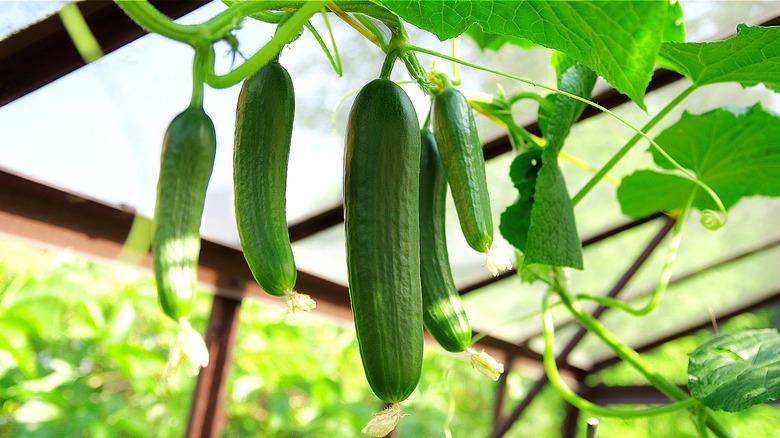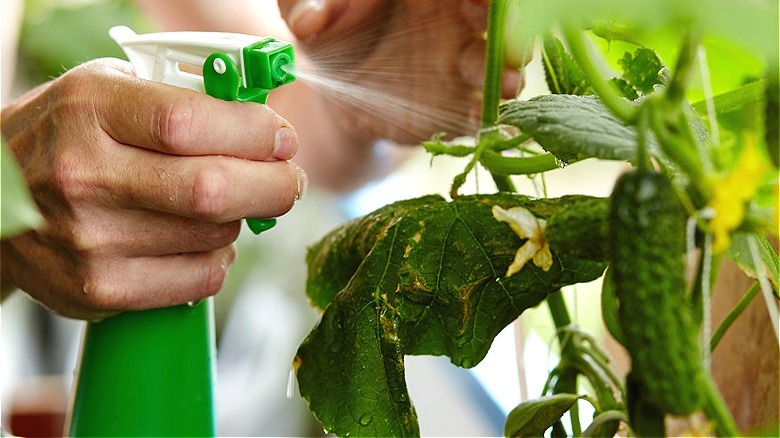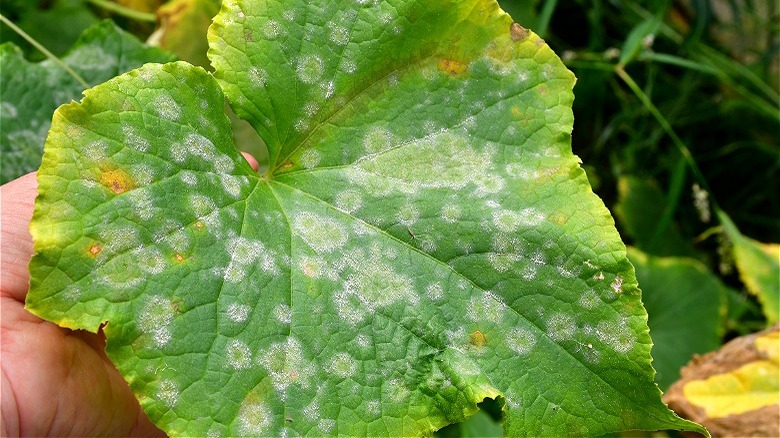The Kitchen Ingredient You'll Want To Start Using On Your Growing Cucumbers
They may not be the most visually flamboyant plants, but underneath their unassuming green exterior, cucumbers are the secret weapon you need for a happy and healthy garden. Botanically classified as a fruit, but culinarily categorized as a vegetable, cucumbers contain nutrients that benefit people consuming them and plants growing next to them. Consequently, cultivating cucumbers is a win-win for home gardeners. Moreover, with help from a common kitchen ingredient, your cucumbers can grow and thrive throughout the season. Treating cucumber plants with baking soda allows you to protect them from disease and harvest premium produce.
It works efficiently to dry out and clean kitchen gloves, remove carpet stains, and deodorize refrigerators, but many homeowners are unaware that baking soda's superpowers are equally effective in the garden. The chemical compound, known as sodium bicarbonate, helps neutralize substances so they're neither too acidic nor too alkaline. In the case of cucumbers, baking soda protects the plant from a common fungal disease called powdery mildew.
Signs of the ailment include white dusty spots on the upper and lower sections of leaves that can expand into larger blemishes if left untreated. Allowing powdery mildew to go unchecked can result in a full-blown infection, which weakens the plant and yields fewer, smaller, and potentially malformed cucumbers. What's more, depending on growing conditions, new fungus spores can easily spread throughout your garden. This is especially true during periods of high winds, as mildew germs can become airborne and quickly taint adjacent cucumber plants.
How to use baking soda to help growing cucumbers
Baking soda treatments are typically applied via spraying. To make a quick and easy homemade version, start by mixing together 1 tablespoon of baking soda, ½ teaspoon of mild liquid dish soap, and 1 gallon of water. Next, pour the solution into a plastic spray bottle and liberally saturate both sides of the cucumber plants' leaves making sure to evenly coat all of the surfaces. In addition, spray the stems to prevent any potential spores from germinating. Powdery mildew can't grow on wet surfaces.
If you are concerned the baking soda spray may not adhere properly to your cucumber plants' leaves, combine 3 tablespoons of baking soda, 1 gallon of water, 2 drops of mild dish soap, and 1 tablespoon of vegetable or cooking oil. The addition of the oil will help the spray better stick to the foliage. Another option to increase binding is to add 1 teaspoon of insecticidal soap or lightweight horticultural oil to the mixture.
You could also blend 4 tablespoons of baking soda with 2 tablespoons of Murphy Oil Soap and 1 gallon of water. Just remember to thoroughly mix all of the ingredients in a clean container prior to applying it to the cucumber plant. Additionally, depending on the age and size of your cucumber plants, you may want to test the spray on a small area of a single, lower leaf before dousing the entire vine with a large amount of the baking soda solution.
Tips for using baking soda on cucumber plants
When applying baking soda solutions to cucumber plants, timing is key. Spray in the early morning so the leaves and stems have a chance to dry without the risk of injury. Drenching your cucumber plant with the baking soda mixture when the sun is at its peak may cause sunscald. As an added safeguard, consider watering your cucumber plants extensively for a couple of days in advance of any baking soda treatment.
Further, while homemade baking soda sprays are safer for your family and the environment than chemical treatments, they're more effective as a preventative measure than an exhaustive cure for cucumber plants that have been completely contaminated by powdery mildew. When using the spray as a proactive means of staving off powdery mildew, apply it once a week and after each time it rains. However, at the first signs of powdery mildew infiltration, drench the plant with the baking soda solution and reapply twice a week. Doing so will change the leaves' pH to create a hostile environment for the fungi. This increase in alkalinity is sufficient enough to kill any spores that may have tainted your cucumber plant.
Finally, despite its appearance, which mimics confectioners' sugar, resist the urge to wipe off powdery mildew with your fingers. This could increase the chances of spreading spores. Instead, use a clean, dry cloth to remove some of the fungus, then follow up by liberally applying the baking soda spray.


